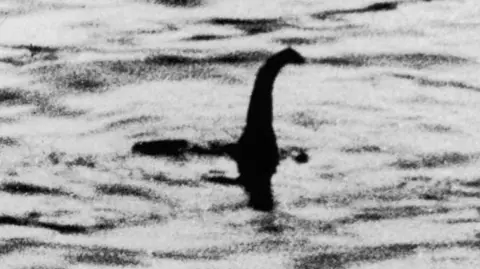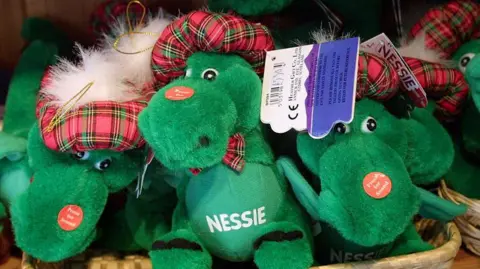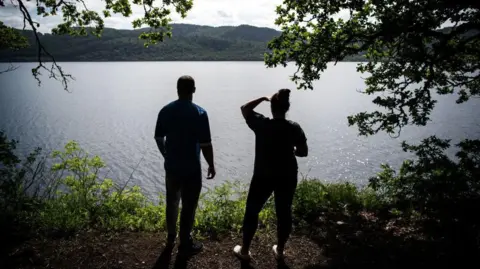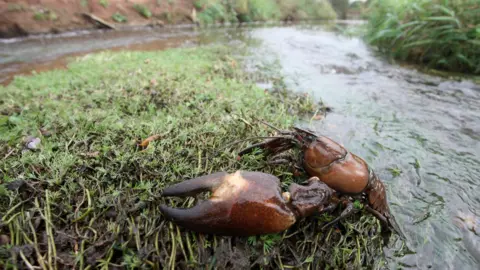What happens if someone finds the Loch Ness Monster?
 Getty Images
Getty ImagesPeople have been looking for Nessie for almost 100 years.
Humps have been seen moving across Loch Ness, and strange sounds heard from beneath the surface - but no actual monster.
A four-day "quest" - the latest in a long series of efforts to unravel the mystery - has been held this week.
But what would happen if the Loch Ness Monster was found - besides, of course, creating a global sensation?
The official plan
 Getty Images
Getty ImagesThe Nessie Contingency Plan sounds like it should be in an episode of TV sci-fi drama The X Files.
But it is a set of guidelines written by Scotland's nature agency, NatureScot.
A spokesperson told us: "The Nessie Contingency Plan was produced back in 2001, at a time when there was a lot of Nessie-hunting activity on the loch.
"We were regularly being asked by the media and others what we would do if or when she, or he, was found.
"The code of practice, which was partly serious and partly for a bit of fun, was drawn up to offer protection not just to the elusive monster, but to any new species found in the loch."
The plan stipulates that a DNA sample should be taken from any new creature, and then it should be released back into the loch.
The animal would also be afforded the same legal protection as Scotland's other native wildlife, such as wildcats and golden eagles.
It means it would be illegal to kill, injure or capture the monster.
The authorities have raised concerns for Nessie in the past.
In 1938 a senior police officer warned the Scottish Office of a planned hunting expedition "determined to catch the monster dead or alive".
The party claimed they were having a special harpoon gun made and were headed for the loch with 20 "experienced men".
How many sightings of a 'monster'?
 Getty Images
Getty ImagesThe legend of a monster dates back to the Middle Ages when Irish monk St Columba is said to have encountered a creature in the Ness, a river that flows from Loch Ness.
The modern myth of Nessie began centuries later.
In April 1933, hotel manageress Aldie Mackay told of seeing a whale-like creature and the loch's water "cascading and churning".
The Inverness Courier newspaper reported the sighting and the editor at the time, Evan Barron, suggested the beast be described as a "monster".
Sightings continue to be made in recent times, with the Official Loch Ness Monster Sightings Register having received 1,161 reports since its launch in 1996.
There were three last year and one report for 2025 so far, according to the register.
This year's sighting described two humps moving across the loch.
Over the years, the reports have included objects moving fast across the loch, and a creature with crocodile-like skin.
Who's looking for Nessie?
 Getty Images
Getty ImagesThere's a long list of people and attempts to find Nessie, or disprove existence of a monster.
The Loch Ness Investigation Bureau carried out searches in the 1960s and 70s.
In the late 1980s, Operation Deepscan saw more than 20 boats make a sonar sweep of the loch.
Then there's Steve Feltham who has dedicated his life to solving the mystery of the Loch Ness Monster.
He gave up his job and sold his home in Dorset to move to Dores on the shores of the loch in 1991.
In 2019, a team of scientists who had visited the loch said giant eels could be behind sightings.
The researchers from New Zealand catalogued all living species in the loch from DNA extracted from water samples.
Following analysis, they ruled out the presence of large animals said to be behind reports of a monster - including a prehistoric plesiosaur or a wandering Greenland shark.
 The Quest
The QuestTwo years ago, a search billed as the biggest Nessie hunt in more than 50 years saw volunteers help record natural - and any unusual - sights from vantage points on land.
During the quest, observers on a boat using acoustic equipment reported four unidentified "gloops" but then realised their recording device wasn't plugged in.
The event, which involved searches on the loch and from shore, was held for a third year last week.
It started on Thursday and ended on Sunday.
Remotely operated vehicles captured underwater photographs of salmon, pike, and a piece of cabling from camera equipment used in a 1970s search.
Would finding something be good news?
 Getty Images
Getty ImagesFor those contingency planners at NatureScot the worry is something unpleasant might be uncovered in Loch Ness.
"Sadly, when we find a new species in a loch it is often an invasive species which has been introduced that is expensive and challenging to deal with," said the spokesperson.
"We ask people to take care not spread these non-native animals and plants into our waterways."
Non-native freshwater species found in Scotland include American mink and North American signal crayfish.
Eating native species and damaging habitats are among the risks they pose.
The spokesperson added: "While the evidence for the existence of the Loch Ness Monster is questionable, the threat posed by climate change and biodiversity loss to all the plants and animals that live in our lochs is all too real."
